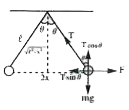Two identical pith balls each of mass 'm' holding charge 'q' each are suspended by silk threads of equal length from same point. They move apart due to repulsion. If the separation between the two balls is 2x and each string makes small angle θ to the vertical.

From fig Tcosθ=mg,Tsinθ=F
Fmg=tanθ=x√12−x2
If θ is small Tanθ≈sinθ≈θ=x1,Fmg>>x1
Where F=14πε0q24x2⇒q216πε0x2mg=x1
⇒x=(q2116πε0mg)1/3
⇒ Tension in the string T=√F2+(mg)2
In the above case if the balls are suspended in a liquid of density ρ and the distance between the balls remains the same, then
Fmg=F1mg1⇒FF1=mgmg1⇒mgmg(1−ρd)(∴k=FaFm)
⇒(1−ρd)=1KorK=dd−p
(d is density of material of the ball)
⇒ In the above case if the charges on the two balls are different and the angles made by those two strings to the vertical are θ1andθ2 respectively, then θ1=θ2 (as F, mg are same) if m1>m2 then θ1<θ2 .
⇒ In the above application if the whole setup is kept in an artificial satellite (in zero gravity region) the angle between the two strings is 180∘ and tension in each string 14πε0q24I2
Similar Questions
Two small balls having equal positive charge Q (coulumb) on each suspended by two insulating strings of equal length L (metre) from a hook fixed to a stand. The whole set-up is taken in a satellite into space where there is no gravity (state of weightlessness). Then tension (newtons) in each string is:
View SolutionTwo small balls, each having charge q, are suspended by two insulating threads of equal length L fron a hook in an elevator. The elevator is freely falling. Calculate the angle etween the two threads and tension in each thread.
View Solution
Knowledge Check
Two identical tennis balls each having mass 'm' and charge 'q' are suspended from a fixed point by threads of length 'l'. What is the equilibrium separation when each thread makes a small angle 'θ' with the vertical ?
Ax=(q2l2πε0mg)1/2Bx=(q2l2πε0mg)1/3Cx=(q2l22πε0m2g)1/3Dx=(q2l22πε0m2g2)1/3Two identical small bodies each of mass m and charge q are suspended from two strings each of length l from a fixed point. This whole system is taken into an orbiting artificial satellite, then find the tensio in strings
AKq2l2+2mgBKq24l2+2mgCKq2l2DKq24l2
Two identical pith balls, each carrying charge q, are suspended from a common point by two strings of equal length l. Find the mass of each ball if the angle between the strings is 2θ in equilibrium.
View SolutionTwo indentical pith balls, each carrying charge q, are suspended from a common point by two strings of equal length l. Find the mass of each ball if the angle between the strings is 2θ in equilibrium.
View SolutionTwo indentical pith balls, each carrying charge q, are suspended from a common point by two strings of equal length l. Find the mass of each ball if the angle between the strings is 2θ in equilibrium.
View SolutionTwo identical small bodies each of mass m and charge q are suspended from two strings each of length l from a fixed point. This whole system is taken into an orbiting artificial satellite, then find the tensio in strings
View SolutionTwo identical small bodies each of mass m and charge q are suspended from two strings each of length l from a fixed point. This whole system is taken into an orbiting artificial satellite, then find the tensio in strings
View SolutionTwo small identical balls P and Q, each of mass 0.866 g, carry identical charges and are suspended by two threads of equal length 50 cm each from the same point. At equilibrium, they are separated by a distance of 50 cm. Find the charge on each ball (in nearest integer in nC).
View Solution
